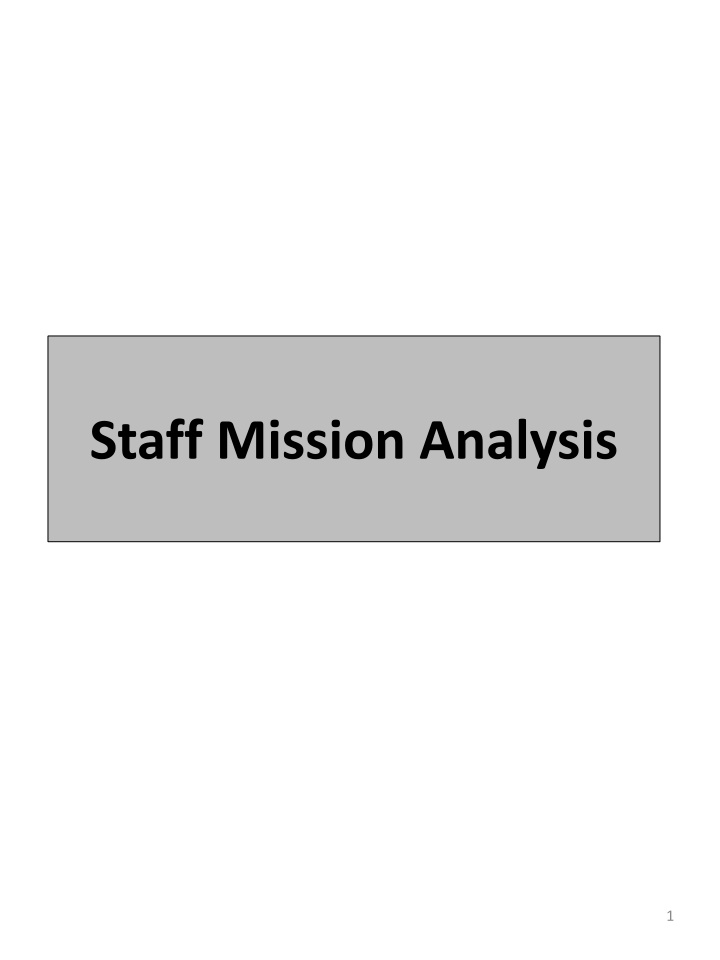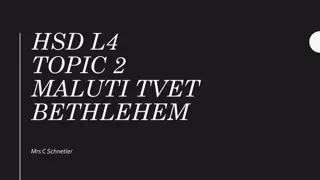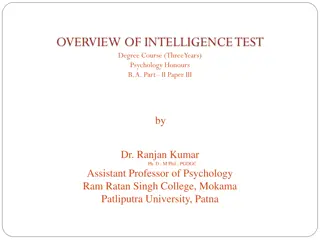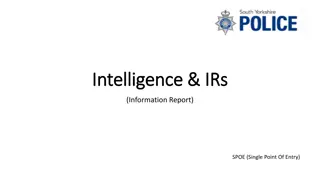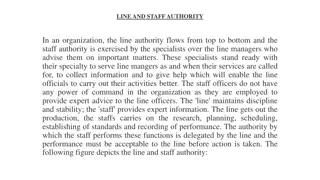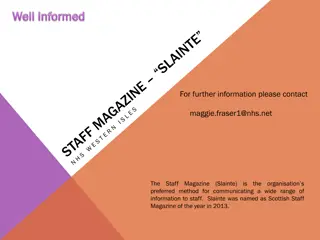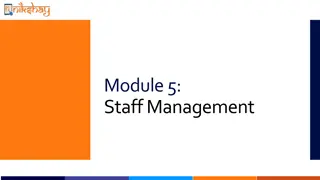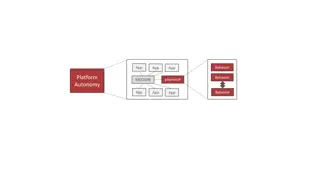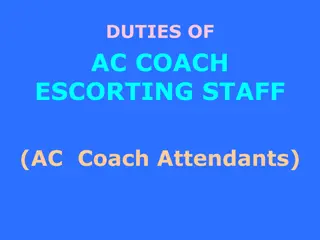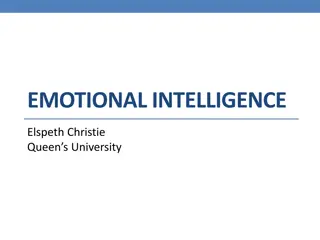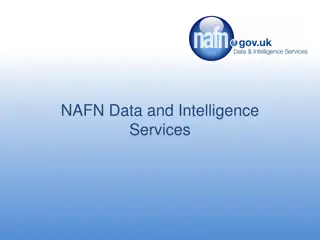Staff Mission and Intelligence Analysis Overview
Intelligence and staff roles within an organization are crucial for operational success. The Intelligence ACOS is responsible for providing intelligence support to operations, while the Staff Weather Officer coordinates weather services through the G-2 (S-2). The Movement and Maneuver ACOS, S/G-3, focuses on planning and executing operations, including troop movements and ammunition supply. These staff members play key roles in supporting decision-making and operational effectiveness.
Download Presentation

Please find below an Image/Link to download the presentation.
The content on the website is provided AS IS for your information and personal use only. It may not be sold, licensed, or shared on other websites without obtaining consent from the author.If you encounter any issues during the download, it is possible that the publisher has removed the file from their server.
You are allowed to download the files provided on this website for personal or commercial use, subject to the condition that they are used lawfully. All files are the property of their respective owners.
The content on the website is provided AS IS for your information and personal use only. It may not be sold, licensed, or shared on other websites without obtaining consent from the author.
E N D
Presentation Transcript
Intelligence ACOS, S/G-2, Intelligence The ACOS, G-2 (S-2) is the chief of the intelligence warfighting function and the principal staff officer responsible for providing intelligence to support current and future operations and plans. This officer gathers and analyzes knowledge on enemy, terrain, weather, and civil considerations for the commander. The G-2 (S-2) leads the staff in the intelligence preparation of the battlefield process and assists the G-3 (S-3) with developing and executing the information collection plan. The G-2 (S-2) provides intelligence support to lethal and nonlethal targeting operations, ensuring units base targeting priorities on intelligence threat assessments and include the priorities in the information collection plan. The G-2 (S-2) prepares Annex B (Intelligence) to the operation order or operation plan. 2
Intelligence Staff Weather Officer The staff weather officer coordinates operational weather support and weather service matters through the G-2 (S-2) and other staff members. The G-2 (S-2) normally assists the staff weather officer with Army staff processes and coordination as required. The staff weather officer is an Air Force officer or noncommissioned officer who serves as a member of the supported commanders special staff. This officer typically leads a team of two or more personnel. These teams are organized as flights or detachments operating in locations under an Air Force weather squadron. The squadron commander assigns teams to provide or coordinate support to one or more Army units. Typically, the staff weather officer is assigned to support Army Service component commands, corps, divisions, combat aviation brigades, brigade combat teams, and special operations forces. This officer focuses on integrating weather into Army decisionmaking processes. Staff weather officer responsibilities include, but are not limited to Providing or overseeing staff, mission and airfield weather services in direct support of the supported Army commander. Integrating tailored mission planning and execution forecasts in support of operational decisionmaking and mission execution. Identifying weather areas of interest and helping manage the Army commander s weather data collection plan. Advising the Air Force on Army operational weather support requirements. 3
Movement and Maneuver ACOS, S/G-3, Operations The G-3 (S-3) has responsibilities for plans and operations. The ACOS, G-3 (S-3) is the chief of the movement and maneuver warfighting function and the principal staff officer responsible for all matters concerning training, operations and plans, and force development and modernization and is the primary staff officer for integrating and synchronizing the operation as a whole for the commander. During plans and operations, the G-3 (S-3) also Develops the information collection annex to plans and orders (with the rest of the staff). Allocates information collection tasks (considering recommendations from the rest of the staff). Integrates fire support into operations. Plans tactical troop movements, including route selection, priority of movement, timing, security, bivouacking, quartering, staging, and preparing movement orders. Develops the ammunition required supply rate (with the G-2 [S-2], chief of fires, and G-4 [S-4]). Requisitions replacement units (through operations channels). Participates in course of action and decision support template development (with the G-2 [S-2] and the chief of fires). Recommends general command post locations. Recommends task organizations and assigns missions to subordinate elements. Supports linguist requirements, to include consolidating linguist requirements and establishing priorities for using linguists. 4
Movement and Maneuver ACOS, S/G-5, Plans The ACOS, G-5 (S-5) is the principal staff officer for planning operations for the mid- to long-range planning horizons. Plans and orders consist of Preparing, coordinating, authenticating, publishing, and distributing operation plans, concept plans, and operation orders. Conducting mission analysis of higher headquarters plans and orders. Reviewing subordinate supporting plans and orders. Coordinating and synchronizing warfighting functions in all plans and orders. In conjunction with the G-3 (S-3), the G-5 (S-5) prepares Annex A (Task Organization), Annex C (Operations), and Annex M (Assessment) to the operation order or operation plan. The G-5 (S-5) has staff coordination responsibility for the military deception officer. The G-5 has staff planning and supervisory responsibility for Overseeing operations beyond the scope of the current order (such as the next operation or the next phase of the current operation). Developing plans, orders, branches, and sequels. Conducting military deception planning. Developing policies, and other coordinating or directive products, such as memorandums of agreement. 5
Movement and Maneuver Aviation The aviation officer is responsible for coordinating Army aviation assets and operations at division, corps, and theater army levels. The aviation officer responsibilities include, but are not limited to Exercising staff supervision and training over Army aviation operations. Monitoring aviation flying-hour, standardization, and safety programs. Planning and supervising Army aviation operations. Providing technical advice and assistance on using Army aviation for evacuation (medical or other). Participating in targeting meetings. 6
Movement and Maneuver Engineer The engineer officer in the protection cell is responsible for planning and assessing survivability operations. The engineer officer prepares Annex G (Engineer) to the operation order or operation plan. Specific duties include, but are not limited to Advising the chief of protection on survivability operations. Coordinating and synchronizing survivability operations. Coordinating with the engineer officer for engineering capabilities. Synchronizing and integrating engineer operations (combat and construction) between multiple command posts and organizations. Writing engineer fragmentary orders, warning orders, and related products. Providing real-time reachback linkage to United States Army Corps of Engineers knowledge centers and supporting national assets. Updating the running estimate. 7
Movement and Maneuver Military Deception The military deception officer is responsible for coordinating military deception assets and operations. The military deception officer resides in the mission command cell, but works within the G-5 plans section. A military deception officer is authorized at corps and theater army levels. At divisions and lower echelons, the commander will designate a military deception officer when necessary. Usually the individual designated by the commander is well versed in the use of Army information-related capabilities that are employed to influence an enemy decisionmaker. The military deception officer provides input to various annexes to the operation order or operation plan as warranted, to include preparing a portion of Annex J (Inform and Influence Activities). Military deception officer responsibilities include, but are not limited to Exercising staff supervision over military deception activities. Providing expertise in military deception operations planning. Managing information required to conduct military deception operations and civil considerations analysis to better determine the effects of ambiguity. Determining requirements or opportunities for military deception operations (with the G-2) through red teaming the adversaries most probable courses of action. Coordinating with the military information support operations planner for support to the deception targets, deception objectives, and deception story. Coordinating with the inform and influence activities staff lead to ensure themes, messages and actions support and enable the military deception plan. Coordinating with the cyber electromagnetic activities (CEMA) staff lead to ensure that CEMA activities support and enable the military deception plan. Producing, distributing, briefing, and coordinating the military deception plan on a need-to-know basis. Coordinating operations security measures to shield the military deception plan with the operations security officer. Integrating military deception assets (both conventional and unconventional). Assessing the execution and effects of military deception operations. 8
Movement and Maneuver Space The space operations officer is in charge of the space support element and is responsible for providing space-related tactical support and coordination of space-based capabilities available to the command. An Army space support team is often placed under operational control to a command, if it has no space operations officer assigned. The team s officer in charge fulfills the space operations officer s responsibilities. The space operations officer prepares Annex N (Space Operations) to the operation order or operation plan. Space operations officer responsibilities include, but are not limited to Advising the commander on the space architectures, capabilities, limitations, and use of theater, strategic, national, and commercial space assets. Calculating, analyzing, and disseminating global positioning system satellite coverage and accuracy data. Facilitating the dynamic retasking of space-based assets to support current and future operations. Assisting in acquiring Department of Defense (DOD) and commercial satellite terrain and weather imagery (classified and unclassified) to enhance mapping, mission analysis, and other actions requiring near real-time imagery from denied areas. Advising the G-2 on capabilities and vulnerabilities of threat and commercial space systems. Providing estimates on the effects of space weather activities on current and future operations and the effects of terrestrial weather on space-based capabilities. Nominating threat or foreign ground stations for targeting (with the G-3 and fire support coordinator). Coordinating the activities of the Army space support team supporting the command. Integrating into special technical operations to maximize all the unique and specialized space-related technical capabilities into operations. 9
Fires Chief of Fires/Fire Support Officer (FSO) The chief of fires is the principal staff officer responsible for the fires warfighting function at division through theater army. At brigade and below, the fire support officer serves as a special staff officer for fires and fire support is coordinated by the S-3. The chief of fires has coordinating responsibility for the air and missile defense officer and the air liaison officer. The chief of fires or fire support officer prepares Annex D (Fires) to the operation order or operation plan. The chief of fires or fire support officers responsibilities include, but are not limited to Developing, with the commander and G-3 (S-3), a scheme of fires to support the operation. Planning and coordinating fire support tasks. Developing a proposed high-priority target list, target selection standards, and an attack guidance matrix. Identifying named and target areas of interest, high-value targets, high- priority targets, and additional events that may influence the positioning of fire support assets. Coordinating positioning of fire support assets. Providing information on the status of fire support systems, target acquisition assets, and field artillery ammunition. Coordinating and synchronizing joint fire support. Coordinating and synchronizing air and missile defense. Managing field artillery ammunition requirements, resupply, and re- allocation. Recommending fire support coordination measures to support current and future operations and managing changes to them. Recommending and implementing the commander s counterfire (including radar zones) and other target engagement priorities. 10
Fires Air Liaison Officer The air liaison officer is responsible for coordinating aerospace assets and operations, such as close air support, air interdiction, air reconnaissance, airlift, and joint suppression of enemy air defenses. The air liaison officer is the senior Air Force officer with each tactical air control party. (See unit SOPs.) Air liaison officer responsibilities include, but are not limited to Advising the commander and staff on employing aerospace assets. Operating and maintaining the Air Force tactical air direction radio network and Air Force air request network. Transmitting requests for immediate close air support and reconnaissance support. Transmitting advance notification of impending immediate airlift requirements. Acting as liaison between air and missile defense units and air control units. Planning the simultaneous employment of air and surface fires. Coordinating tactical air support missions with the chief of fires or fire support officer, and the appropriate airspace command and control element. Supervising forward air controllers and the tactical air control party. Integrating air support sorties with the Army concept of operations. Participating in targeting team meetings. Directing close air support missions. Providing Air Force input into airspace command and control. 11
Fires Electronic Warfare Officer The electronic warfare officer is a specially trained officer who performs electronic warfare duties. The electronic warfare officer prepares a portion of Annex C (Operations) and Annex D (Fires) to the operation order or operation plan. Electronic warfare officer responsibilities include, but are not limited to Leading the electronic warfare element in the mission command cell. Integrating and synchronizing cyber electromagnetic activities. Coordinating, preparing, and maintaining the electronic warfare target list, electronic attack taskings, electronic attack requests, and the electronic warfare portion of the sensor/attack matrix. Coordinating with other staff when conducting electronic warfare. Assessing opponent vulnerabilities, friendly capabilities, and friendly missions in electronic warfare terms. Developing a prioritized adversary target list based on high-value targets and high-payoff targets (with the chief of fires and fire support officer). Coordinating the electronic attack target list with organic military intelligence units and with adjacent and higher commands, including joint and multinational commands when appropriate. Coordinating with the higher headquarters electronic warfare officer to deconflict inform and influence activities on the communications spectrum. 12
Protection Chief of Protection The chief of protection is the principal staff officer responsible for the protection warfighting function at division through theater army. The chief of protection is the principal advisor to the commander on all matters relating to the protection warfighting function. Brigade and lower echelon headquarters are not assigned a chief of protection. The chief of protection has coordinating staff responsibilities for the chemical, biological, radiological, and nuclear officer; the explosive ordnance disposal officer; the operations security officer; the personnel recovery officer; the provost marshal; and the safety officer. The S-3 has coordinating staff responsibility for the above staff officers at brigade and below headquarters. The chief of protection prepares Annex E (Protection) to the operation order or operation plan. The chief of protection s responsibilities include, but are not limited to Directing analysis, planning, and coordinating protection functions and missions. Advising the commander on the allocation and employment of all assigned or attached protection assets. Chairing the protection working group. Coordinating input and making recommendations to the commander on the assets to be included in the critical and defended asset lists. Monitoring and assessing the protection effort. Conducting staff coordination with other headquarters cells, nodes, and functional groupings. Managing protection support for major operations. Synchronizing protection operations between CPs. Managing training and materiel enhancements. Providing guidance on protection systems and the execution of protection tasks. 13
Protection Air and Missile Defense Coordinator The air and missile defense officer is responsible for coordinating air and missile defense activities and plans with the area air and missile defense commander, joint force air component commander (JFACC), and airspace control authority. The air and missile defense officer coordinates the planning and use of all joint air and missile defense systems, assets, and operations. Army forces air and missile defense plans are synchronized with the area air defense commander s area air defense plan, the JFACC s joint air operations plan and daily air tasking order (ATO), and the airspace control authority s airspace control plan, and daily airspace control order (ACO). The air and missile defense officer prepares a portion of Annex D (Fires) to the operation order or operation plan. The air and missile defense officer is the senior air defense artillery officer in the command and the commander of an air defense artillery unit supporting it. An air and missile defense officer is authorized at the division, corps, and theater army levels. Examples of air and missile defense officer responsibilities include, but are not limited to Disseminating ATO and ACO intelligence to air defense artillery units. Integrating airspace coordinating measures to support air and missile defense operations. Recommending active and passive air defense measures. Determining requirements and recommending assets to support air and missile defense. Planning and coordinating airspace use with other staff. Providing information on the status of air and missile defense systems, air and missile attack early warning radars, and air defense artillery ammunition. Estimating the adequacy of the air defense artillery ammunition controlled supply rate. Coordinating and synchronizing Army forces air and missile defense with joint force air and missile defense. 14
Protection Chemical, Biological, Radiological, and Nuclear (CBRN) Officer The chemical, biological, radiological, and nuclear (CBRN) officer is responsible for CBRN operations, obscuration operations, and CBRN asset use. The CBRN officer prepares a portion of Annex E (Protection) and a portion of Annex C (Operations) to the operation order or operation plan. The CBRN officer s responsibilities include, but are not limited to Recommending courses of action to minimize friendly and civilian vulnerability, and assessing the probability and effect of CBRN- related casualties. Assessing the probability and effect of CBRN-related casualties. Coordinating across the entire staff while assessing the effect of enemy CBRN-related attacks and hazards on current and future operations. Coordinating health system support requirements for CBRN operations with the surgeon. Coordinating with other staff for CBRN-related operations. Planning, supervising, and coordinating CBRN decontamination (except patient decontami-nation) operations. Assessing weather and terrain data to determine environmental effects on potential CBRN hazards and threats. Overseeing construction of CBRN shelters. Planning and recommending integration of obscuration into tactical operations. Advising the commander on CBRN hazards and passive defense measures. 15
Protection Explosives Ordnance Disposal Officer The explosive ordnance disposal officer is responsible for coordinating the detection, identification, recovery, evaluation, rendering ordnance safe, and final disposal of explosive ordnance. An explosive ordnance disposal officer is authorized at corps and divisions and normally serves as the explosive ordnance disposal group, battalion, and company commander. The explosive ordnance disposal officer prepares a portion of Annex E (Protection) to the operation order or operation plan. Explosive ordnance disposal officer responsibilities include, but are not limited to Establishing and operating an explosive ordnance disposal incident reporting system. Establishing, operating, and supervising technical intelligence reporting procedures. Coordinating requirements for explosive ordnance disposal support with requesting units, other Army commands, other Services, federal agencies, and multinational partners. Coordination may include arranging for administrative and logistic support for subordinate explosive ordnance disposal units. Monitoring the supply status of and expediting requests for special explosive ordnance disposal tools, equipment, and demolition materials. 16
Protection Operations Security Officer The operations security officer is responsible for the command s operations security program. The operations security officer prepares a portion of Annex E (Protection) to the operation order or operation plan. The operations security officer s responsibilities include, but are not limited to Identifying and recommending the essential elements of friendly information (EEFIs). Conducting analysis of adversaries as part of the intelligence preparation of the battlefield (IPB) process. Conducting analysis of vulnerabilities as part of the IPB process. Assessing operations security risk. Developing, coordinating, and applying operations security measures across the staff. Writing the running estimate for operations security. Writing the operations security appendix to the protection annex. Monitoring, assessing, and adjusting operations security as required. Reviewing internal staff documents, information system logs, and news releases for sensitive information and potential compromise of EEFIs. Searching news sources, web logs (blogs), and other web sites for sensitive information and compromise of EEFIs. Attending the inform and influence activities working group as required. 17
Protection Personnel Recovery Officer The personnel recovery officer is responsible for the coordination of all personnel recovery related matters. The personnel recovery officer prepares a portion of Annex E (Protection) to the operation order or operation plan. Personnel recovery officer duties include, but are not limited to Developing and maintaining of the organization s personnel recovery program. Recommending recovery courses of action to the commander. Coordinating personnel recovery issues, both vertically and horizontally. Developing personnel recovery SOPs, plans, and annexes. Supporting joint personnel recovery or establishing a joint personnel recovery center as required. Assisting personnel recovery officers developing subordinate recovery programs. 18
Protection Provost Marshal The provost marshal is responsible for planning, coordinating, and employing all organic, assigned, or attached military police assets. Usually the senior military police officer in the command, the provost marshal augments the staff with a small planning cell that typically works within the G-5. A provost marshal is authorized at corps and division headquarters. The provost marshal prepares a portion of Annex C (Operations) and a portion of Annex E (Protection) to the operation order or operation plan. Provost marshal responsibilities include, but are not limited to Conducting maneuver and mobility support operations, including route reconnaissance, surveillance, circulation control, dislocated civilian and straggler control, and information dissemination. Directing components of area security operations, including activities associated with antiterrorism operations, zone and area reconnaissance, checkpoint access control, and physical security of critical assets, nodes, and sensitive materials. Managing, in coordination with the G-4, the internment and resettlement of enemy prisoners of war, civilian internees, dislocated civilians, and U.S. military prisoners. Coordinating and directing law and order operations, including liaison with local civilian law enforcement authorities. Conducting police intelligence operations, including activities related to the collection, assessment, development, and dissemination of police intelligence products. Coordinating customs and counterdrug activities. Providing physical security guidance for commanders. Assisting with area damage control and CBRN detection and reporting. Helping the G-1 (AG) administer discipline, law, and order. Preparing statistical data on absent without leave and desertion to the G-1 (AG) through the chief of protection. Coordinating, along with the G-4, for all logistic requirements relative to enemy prisoners of war, civilian internees, U.S. military prisoners, and dislocated civilians. 19
Protection Safety The safety officer coordinates safety activities throughout the command. Commanders at every echelon from battalion through corps appoint a safety officer. An aviation safety officer is authorized for corps staffs and all aviation units. The safety officer prepares a portion of Annex E (Protection) to the operation order or operation plan. Safety officer responsibilities include, but are not limited to Implementing the command safety and occupational health program. Implementing the accident prevention program. Coordinating with the inspector general and provost marshal on correcting unsafe trends identified during inspections. Providing input to the G-1/AG (S-1) on projected accident losses. Providing safety training to the local civilian labor force. Reviewing risk assessments and recommending risk-reduction control measures for all operations. 20
Sustainment Chief of Sustainment The chief of sustainment is the principal staff officer responsible for coordinating all matters concerning the sustainment warfighting function at division and higher echelon headquarters. Brigade and lower echelon headquarters are not authorized a chief of sustainment. The S-4 serves as the principal coordinator of sustainment for brigade and lower echelon headquarters. The chief of sustainment has coordinating staff responsibility for the G-1, G-4, and G-8. At division and higher echelon headquarters, the chief of sustainment prepares Annex F (Sustainment) to the operation order or operation plan. 21
Sustainment ACOS, S/G-1, Personnel The ACOS, G-1 (S-1) is the principal staff officer for all matters concerning human resources support (military and civilian). The G-1 (S-1) also serves as the senior adjutant general officer in the command. Specific responsibilities of the G-1 (S-1) include manning, personnel services, personnel support, and headquarters management. The G-1 (S-1) prepares a portion of Annex F (Sustainment) to the operation order or operation plan. 22
Sustainment ACOS, S/G-4, Logistics The ACOS, G-4 (S-4) is the principal staff officer for sustainment plans and operations (general), supply, maintenance, transportation, services, and operational contract support. The G-4 (S-4) helps the support unit commander maintain logistics visibility with the commander and the rest of the staff. The G-4 (S-4) has staff coordinating responsibility of the transportation officer and the air mobility officer. The G-4 (S-4) prepares Annex F (Sustainment) and Annex P (Host-Nation Support) to the operation order or operation plan. The G-4 (S-4) responsibilities for sustainment plans and operations (general) include, but are not limited to Developing the logistic plan to support operations (with the G-3 [S- 3]). Coordinating with the G-3 (S-3), G-2 (S-2), and engineer officer to requisition cataloged topographic foundation data and existing mission-specific data sets from the Defense Logistics Agency. Coordinating with the G-3 (S-3) and G-1/AG (S-1) on equipping replacement personnel and units. Coordinating with the support unit commander on the current and future support capability of that unit. Coordinating the selection of main supply routes and logistic support areas (with the engineer officer) and recommending them to the G-3 (S-3). Performing logistic preparation of the battlefield (with the support command). Recommending command policy for collecting and disposing of excess property and salvage. 23
Sustainment ACOS, G-8, Resource Management The ACOS, G-8 is singularly responsible for all financial management (resource management and finance operations) within the theater. 24
Sustainment Command Surgeon The surgeon is responsible for coordinating health assets and operations within the command. This officer provides and oversees medical care to Soldiers, civilians, and enemy prisoners of war. Medical organizations from battalion through corps level are authorized a surgeon. The surgeon prepares a portion of Annex E (Protection) and Annex F (Sustainment) to the operation order or operation plan. Surgeon responsibilities include, but are not limited to Providing health education and training. Coordinating medical evacuation, including Army dedicated medical evacuation platforms (air and ground). Overseeing veterinary food inspection, animal care, and veterinary preventive medicine activities of the command (with the veterinary officer). Overseeing medical laboratory services. Providing preventive medicine services. Supervising and preparing health-related reports and statistics. Advising on the effects of the medical threat on personnel, rations, and water. Advising how operations affect the public health of personnel and the indigenous populations. 25
Sustainment Transportation Officer The transportation officer coordinates transportation assets and operations and also prepares a portion of Annex F (Sustainment). Transportation officer responsibilities include, but are not limited to Planning and directing administrative movements, including onward movement from ports of debarkation, sustainment movements, and other movements as directed. Planning movement scheduling and regulations of main supply routes. Planning the mode of operations (truck, rail, air, and water). Planning the movement of materiel and personnel. Monitoring movements on routes two echelons down. 26
Mission Command ACOS, S/G-6, Signal The ACOS G-6 (S-6) is the principal staff officer for all matters concerning communications, electromagnetic spectrum operations, and networks within the unit s area of operations. The G-6 (S-6) prepares Annex H (Signal) to the operation order or operation plan. G-6 (S-6) responsibilities include, but are not limited to Managing and controlling all network capabilities and services. Preparing and maintaining network operations estimates, plans, and orders. Monitoring and making recommendations on all technical network operations activities. Coordinating and managing electromagnetic spectrum operations and communications security within the area of operations. Establishing and overseeing procedures to disseminate intelligence throughout the area of operations. Establishing automation systems administration procedures for all information systems. Assessing network operations vulnerability and risk management with the G-2 (S-2), G-3 (S-3), operations security officer, and G-7. Recommending command post (CP) locations, based on operational requirements and the information environment. Recommending communications- and network-related essential elements of friendly information. Coordinating contractor support for all cyber electromagnetic systems. Managing and distributing official military mail. 27
Mission Command ACOS, S/G-7, Inform and Influence Activities The ACOS, G-7 (S-7) is the principal staff officer responsible for planning, coordinating, and integrating inform and influence activities of the command. The G-7 (S-7) assists the commander to establish, synchronize, and integrate actions with information themes and messages. This coordination provides consistent messages to diverse audiences, including foreign friendly, neutrals, adversaries, and enemies. The G-7 (S-7) has staff coordination responsibility for synchronizing, deconflicting, and integrating public affairs, military information support operations, Soldier and leader engagement, military deception, and commander-designated enablers. The G-7 (S-7) prepares Annex J (Inform and Influence Activities) to the operation order or operation plan. 28
Mission Command ACOS, S/G-9, Civil Affairs Operations The ACOS, G-9 (S-9) is responsible for all matters concerning civil affairs. The G-9 (S-9) establishes the civil-military operations center, evaluates civil considerations during mission analysis, and prepares the groundwork for transitioning the area of operations from military to civilian control. The G-9 (S-9) advises the commander on the military s effect on civilians in the area of operations, relative to the complex relationship of these people with the terrain and institutions over time. The G-9 (S-9) is responsible for enhancing the relationship between Army forces and the civil authorities and people in the area of operations. The G-9 (S-9) is required at all echelons from battalion through corps but is authorized only at division and corps. Once deployed, units below division level may be authorized an S-9. The G-9 (S-9) prepares Annex K (Civil Affairs Operations) to the operation order or operation plan. 29
Mission Command ACOS, S/G-9, Civil Affairs Operations G-9 (S-9) responsibilities include, but are not limited to Advising the commander on legal and moral obligations incurred from the long- and short-term effects (economic, environmental, and health) of military operations on civilian populations. Operating a civil-military operations center to maintain liaison with other U.S. government agencies, host-nation civil and military authorities, and nongovernmental and international organizations in the area of operations. Coordinating with the chief of fires or fire support officer on protected targets. Planning community relations programs to gain and maintain public understanding and goodwill and to support military operations. Providing the G-2 (S-2) information gained from civilians in the area of operations. Coordinating with the surgeon on the military use of civilian medical facilities, materials, and supplies. Coordinating with the G-7 officer to ensure disseminated information is not contradictory. Coordinating with the public affairs office on supervising public information media under civil control. Providing instruction to units, officials (friendly, host-nation civil, or host- nation military), and the population on identifying, planning, and implementing programs to support civilian populations and strengthen host- nation internal defense and development. Identifying and assisting the G-6 (S-6) with coordinating military use of local information systems. Coordinating with the provost marshal to control civilian traffic in the area of operations. Helping the G-4 (S-4) coordinate facilities, supplies, and other materiel resources available from the civil sector to support operations. 30
Public Affairs Officer (PAO) The public affairs officer understands and coordinates the flow of information to Soldiers, the Army community, and the public. The ACOS, G-7 exercises coordinating staff responsibility for the public affairs officer. The public affairs officer prepares a portion of Annex J (Inform and Influence Activities) to the operation order or operation plan. Public affairs officer responsibilities include, but are not limited to Planning and supervising the command public affairs program. Advising and informing the commander of the public affairs impact and implications of planned or current operations. Serving as the command representative for all communications with external media. Assessing the information requirements and expectations of the Army and the public, monitoring media and public opinion, and evaluating the effectiveness of public affairs plans and operations. Coordinating logistic and administrative support of civilian journalists under unit administrative control. Conducting liaison with media representatives to provide accreditation, mess, billet, transport, and escort as authorized and appropriate. Developing and educating the command on policies and procedures for protecting against the release of information detrimental to the mission, national security, and personal privacy. Coordinating with the G-7, military information support officer, and G-9 to ensure disseminated information is not contradictory. 31
Knowledge Management Officer (KM) The knowledge management officer (KMO) directs the knowledge management (KM) section. KMOs ensure that units understand the KM process and procedures. They demonstrate how these processes and procedures can improve efficiency and shared understanding during training and enhance operational effectiveness during operations, especially in time- constrained environments. KMOs need not remain in the command post. Commanders may require their KMO to move with them. The knowledge management officer duties and responsibilities include, but are not limited to Assisting staff performance of internal and external knowledge gap analyses and creating techniques to bridge gaps. Recommending the creation of an organizational knowledge network and providing metrics for evaluating its effectiveness. Creating a unit KM plan and executing it through the unit staff and ensuring that the KM section fully supports this plan. Continuously assessing KM as it applies to staff readiness, unit infrastructure, and unit performance. Advising the commander and staff on integrating KM practices and procedures throughout the organization. Monitoring emerging KM trends for incorporation into unit operations. Monitoring formal and informal social networks that transfer knowledge (that is, who the subject matter experts are, who goes to them, and what connects seekers with subject matter experts). Facilitating achieving greater knowledge creation and transfer across the organization. Seeking feedback to evaluate the progress of knowledge sharing initiatives. Showing staff teams how to develop knowledge sharing within their areas of expertise. Developing KM policies and procedures and ensuring command-wide dissemination. Developing effective techniques and procedures for organizing, applying, and transferring observations, insights, and lessons from after action reviews into unit operations, standard operating procedures, and training. Overseeing planning and implementing KM activities across the unit by communicating with other commands KM officers, both horizontally and vertically. Establishing and chairing a working group made up of staff representatives and KM officers from subordinate units. Planning the creation, management, and monitoring of active participation in a knowledge architecture within the unit s organizational structure to facilitate operational synchronization and operational adaptability. Coordinating and overseeing the unit s KM training using Army professional forums training assets. Overseeing the unit s content management efforts. Serving as the chief architect for the KM structure and understanding the functions of its information systems in order to provide advice on integrating their products into the common operational picture. Coordinating with the signal staff officer to ensure that the unit s information systems network supports knowledge creation, organization, application, and transfer across the unit. Assisting subordinate units without KM sections in managing knowledge. 32
Judge Advocate (JAG) The Staff Judge Advocate serves under the supervision of the COS to provide legal services to the staff and, through other staff members, responsive legal services throughout the command. The ACOS (G-1) exercises coordinating staff responsibility over the Staff Judge Advocate, when required. A legal support element typically composed of three judge advocates deploys in direct support of each brigade-level task force. The staff judge advocate prepares a portion of Annex C (Operations) to the operation order or operation plan. The Staff Judge Advocate provides complete legal support encompassing the six core legal disciplines. Staff Judge Advocate responsibilities include, but are not limited to Providing military justice advice and performing military justice duties prescribed in the Uniform Code of Military Justice. Resolving legal problems regarding administrative boards, investigations, or other military tribunals. Providing technical supervision and training of legal personnel and subjects. Providing legal advice and assistance. Providing legal counsel to the civilian personnel office, equal opportunity advisor, family advocacy case review committee, and the command. Serving as the command ethics counselor. Providing international law and operational law assistance, including advice and assistance on implementing the DOD law of war program. Assisting with litigation in which the United States has an interest. 33
Military Information Support Officer The military information support officer is responsible for synchronizing military information support operations (MISO) with elements conducting other inform and influence. A military information support officer is authorized at theater army, corps, and division headquarters levels. A military information support noncommissioned officer is authorized at the brigade combat team level. If no military information support noncommissioned officer is assigned, the commander of an attached military information support element may assume the military information support staff officer s responsibilities. The military information support officer prepares a portion of Annex J (Inform and Influence Activities) to the operation order or operation plan. (See MISO doctrine and FM 7-15 for more details.) Responsibilities include, but are not limited to Coordinating with the G-7 to ensure synchronization of MISO. Planning, coordinating, and synchronizing MISO to support the overall operation. Recommending prioritization of the efforts of attached military information support forces. Evaluating enemy information efforts and the effectiveness of friendly MISO on target groups (with the G-2 and G-9). Assessing MISO effectiveness. Assessing the psychological impact of military operations on the enemy and the civilian populace. Assessing the potential effects of adversary information and determining the best response, if any, in conjunction with the G-7 and public affairs officer. Assisting military deception operations in developing a deception story to meet command objectives. 34
